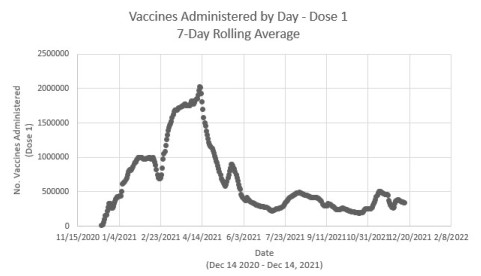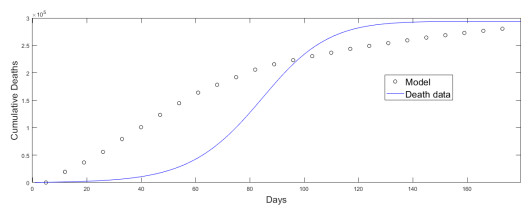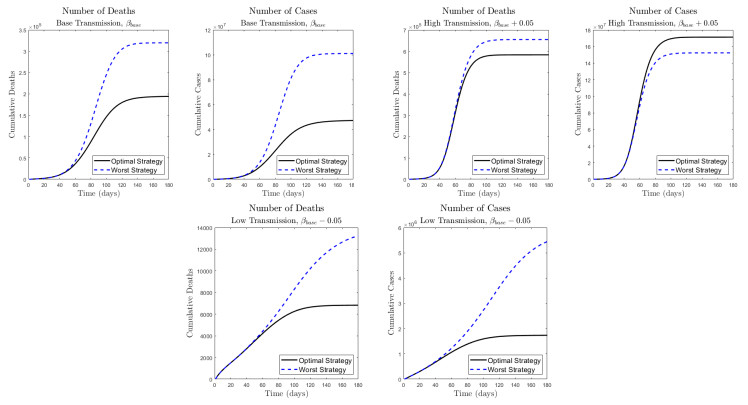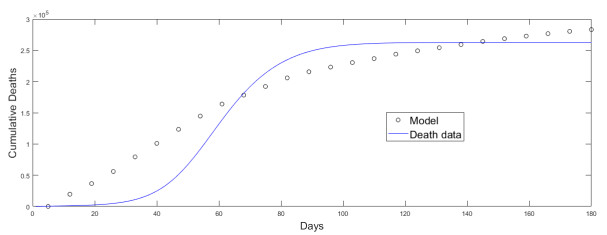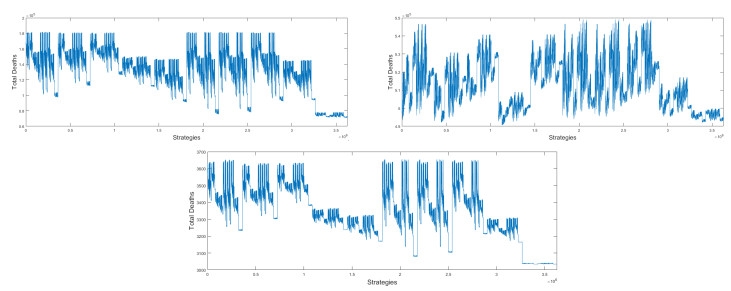|
[1]
|
A. R. Tuite, L. Zhu, D. N. Fisman, J. A. Salomon, Alternative dose allocation strategies to increase benefits from constrained COVID-19 vaccine supply, Ann. Int. Med., 2021. https://doi.org/10.7326/M20-8137 doi: 10.7326/M20-8137

|
|
[2]
|
B. Balcik, E. Yucesoy, B. Akca, S. Karakaya, A. A. Gevsek, H. Baharmand, et al., A mathematical model for equitable in-country COVID-19 vaccine allocation, Int. J. Production Res., 60 (2022), 7502–7526. https://doi.org/10.1080/00207543.2022.2110014 doi: 10.1080/00207543.2022.2110014

|
|
[3]
|
K. M. Bubar, K. Reinholt, S. M. Kissler, M. Lipsitch, S. Cobey, Y. H. Grad, et al., Model-informed COVID-19 vaccine prioritization strategies by age and serostatus, Science, 371 (2021), 916–921. https://doi.org/10.1126/science.abe6959 doi: 10.1126/science.abe6959

|
|
[4]
|
M. Coccia, Pandemic prevention: Lessons from COVID-19, Encyclopedia, 1 (2021), 36. https://doi.org/10.3390/encyclopedia1020036 doi: 10.3390/encyclopedia1020036

|
|
[5]
|
C. Magazzino, M. Mele, M. Coccia, A machine learning algorithm to analyse the effects of vaccination on COVID-19 mortality, Epidemiol. Infect., 150 (2022), e168. https://doi.org/10.1017/S0950268822001418 doi: 10.1017/S0950268822001418

|
|
[6]
|
M. Frieman, A. D Harris, R. S. Herati, F. Krammer, A. Mantovani, M. Rescigno, et al., Sars-cov-2 vaccines for all but a single dose for covid-19 survivors, EBioMedicine, 68 (2021). https://doi.org/10.1016/j.ebiom.2021.103401 doi: 10.1016/j.ebiom.2021.103401

|
|
[7]
|
A. B. Hogan, P. Winskill, O. J. Watson, P. GT. Walker, C. Whittaker, M. Baguelin, et al., Within-country age-based prioritisation, global allocation, and public health impact of a vaccine against SARS-CoV-2: A mathematical modelling analysis, Vaccine, 39 (2021), 2995–3006. https://doi.org/10.1016/j.vaccine.2021.04.002 doi: 10.1016/j.vaccine.2021.04.002

|
|
[8]
|
K. Liu, Y. Lou, Optimizing COVID-19 vaccination programs during vaccine shortages: A review of mathematical models, Infect. Disease Model., 2022. https://doi.org/10.1016/j.idm.2022.02.002 doi: 10.1016/j.idm.2022.02.002

|
|
[9]
|
C.. MacIntyre, V. Costantino, M. Trent, Modelling of COVID-19 vaccination strategies and herd immunity, in scenarios of limited and full vaccine supply in NSW, Australia, Vaccine, 40 (2022), 2506–2513. https://doi.org/10.1016/j.vaccine.2021.04.042 doi: 10.1016/j.vaccine.2021.04.042

|
|
[10]
|
H. Y. Mak, T. Dai, C. S. Tang, Managing two-dose COVID-19 vaccine rollouts with limited supply: Operations strategies for distributing time-sensitive resources, Product. Operat. Manag., 31 (2022), 4424–4442. https://doi.org/10.1111/poms.13862 doi: 10.1111/poms.13862

|
|
[11]
|
E. G. Martin, G. S. Birkhead, D. R. Holtgrave, Maintaining a focus on health equity during the COVID-19 vaccine rollout, J. Public Health Manag. Pract., 27 (2021), 226–228. https://doi.org/10.1097/PHH.0000000000001359 doi: 10.1097/PHH.0000000000001359

|
|
[12]
|
E. B. Noh, H. K. Nam, H. Lee, Which group should be vaccinated first?: A systematic review, Infect. Chemother., 53 (2021), 261–270.
|
|
[13]
|
S. K. Sarkar, Md M. Morshed, Spatial priority for COVID-19 vaccine rollout against limited supply, Heliyon, 7 (2021), e08419. https://doi.org/10.1016/j.heliyon.2021.e08419 doi: 10.1016/j.heliyon.2021.e08419

|
|
[14]
|
E. Shim, Optimal allocation of the limited COVID-19 vaccine supply in South Korea, J. Clin. Med., 10 (2021), 591. https://doi.org/10.3390/jcm10040591 doi: 10.3390/jcm10040591

|
|
[15]
|
Y. Su, Y. Li, Y. Liu, Common demand vs. limited supply—how to serve the global fight against COVID-19 through proper supply of COVID-19 vaccines, Int. J. Environ. Res. Public Health, 19 (2022), 1339. https://doi.org/10.3390/ijerph19031339 doi: 10.3390/ijerph19031339

|
|
[16]
|
Md R. Islam, T. Oraby, A. McCombs, M. M. Chowdhury, M. Al-Mamun, M. G. Tyshenko, et al., Evaluation of the United States COVID-19 vaccine allocation strategy, PloS One, 16 (2021), e0259700. https://doi.org/10.1371/journal.pone.0259700 doi: 10.1371/journal.pone.0259700

|
|
[17]
|
M. Coccia, Sources, diffusion and prediction in COVID-19 pandemic: Lessons learned to face next health emergency, AIMS Public Health, 10 (2023), 145–168. https://doi.org/10.3934/publichealth.2023012 doi: 10.3934/publichealth.2023012

|
|
[18]
|
M. Coccia, Covid-19 pandemic over 2020 (with lockdowns) and 2021 (with vaccinations): similar effects for seasonality and environmental factors, Environ. Res., 208 (2022), 112711. https://doi.org/10.1016/j.envres.2022.112711 doi: 10.1016/j.envres.2022.112711

|
|
[19]
|
I. Benati, M. Coccia, Global analysis of timely COVID-19 vaccinations: Improving governance to reinforce response policies for pandemic crises, Int. J. Health Govern., (ahead-of-print), (2022). https://doi.org/10.1108/IJHG-07-2021-0072
|
|
[20]
|
S. Bansal, B. Pourbohloul, L. A. Meyers, A comparative analysis of influenza vaccination programs. PLoS Med., 3 (2006), e387. https://doi.org/10.1371/journal.pmed.0030387 doi: 10.1371/journal.pmed.0030387

|
|
[21]
|
D. Weycker, J. Edelsberg, M. E. Halloran, I. M. Longini Jr, A. Nizam, V. Ciuryla, et al., Population-wide benefits of routine vaccination of children against influenza, Vaccine, 23 (2005), 1284–1293. https://doi.org/10.1016/j.vaccine.2004.08.044 doi: 10.1016/j.vaccine.2004.08.044

|
|
[22]
|
M. Ratti, D. Concina, M. Rinaldi, E. Salinelli, A. M. Di Brisco, D. Ferrante, et al., Vaccination strategies against seasonal influenza in long term care setting: Lessons from a mathematical modelling study, Vaccines, 11 (2022), 32. https://doi.org/10.3390/vaccines11010032 doi: 10.3390/vaccines11010032

|
|
[23]
|
F. G. Sandmann, E. van Leeuwen, S. Bernard-Stoecklin, I. Casado, J. Castilla, L. Domegan, et al., Health and economic impact of seasonal influenza mass vaccination strategies in European settings: A mathematical modelling and cost-effectiveness analysis, Vaccine, 40 (2022), 1306–1315. https://doi.org/10.1016/j.vaccine.2022.01.015 doi: 10.1016/j.vaccine.2022.01.015

|
|
[24]
|
J. F. Vesga, M. H. Clark, E. Ayazi, A. Apolloni, T. Leslie, W. J. Edmunds, et al., Transmission dynamics and vaccination strategies for Crimean-Congo haemorrhagic fever virus in Afghanistan: A modelling study, PLoS Neglect. Trop. Diseases, 16 (2022), e0010454. https://doi.org/10.1371/journal.pntd.0010454 doi: 10.1371/journal.pntd.0010454

|
|
[25]
|
R.J. Villanueva, V. Sánchez-Alonso, L. Acedo, A mathematical model for human papillomavirus vaccination strategies in a random network, Math. Methods Appl. Sci., 45 (2022), 3284–3294. https://doi.org/10.1002/mma.7205 doi: 10.1002/mma.7205

|
|
[26]
|
Y. Choi, J. S. Kim, J. E. Kim, H. Choi, C. H. Lee, Vaccination prioritization strategies for COVID-19 in Korea: A mathematical modeling approach, Int. J. Environ. Res. Public Health, 18 (2021), 4240. https://doi.org/10.3390/ijerph18084240 doi: 10.3390/ijerph18084240

|
|
[27]
|
M. L. Diagne, H. Rwezaura, S. Y. Tchoumi, J. M. Tchuenche, A mathematical model of COVID-19 with vaccination and treatment, Comput. Math. Methods Med., 2021 (2021). https://doi.org/10.1155/2021/1250129 doi: 10.1155/2021/1250129

|
|
[28]
|
J. P. Gutiérrez-Jara, C. Saracini, Risk perception influence on vaccination program on COVID-19 in Chile: A mathematical model, Int. J. Environ. Res. Public Health, 19 (2022), 2022. https://doi.org/10.3390/ijerph19042022 doi: 10.3390/ijerph19042022

|
|
[29]
|
A. Rǎdulescu, C. Williams, K. Cavanagh, Management strategies in a SEIR-type model of COVID 19 community spread, Sci. Rep., 10 (2020), 1–16. https://doi.org/10.1038/s41598-020-77628-4 doi: 10.1038/s41598-020-77628-4

|
|
[30]
|
T. Tran, N. B. Wikle, E. Albert, H. Inam, E. Strong, K. Brinda, et al., Optimal SARS-CoV-2 vaccine allocation using real-time attack-rate estimates in Rhode Island and Massachusetts, BMC Med., 19 (2021), 1–14. https://doi.org/10.1186/s12916-021-02038-w doi: 10.1186/s12916-021-02038-w

|
|
[31]
|
C. Zuo, Z. Meng, F. Zhu, Y. Zheng, Y. Ling, Assessing vaccination prioritization strategies for COVID-19 in South Africa based on age-specific compartment model, Front. Public Health, 10 (2022). https://doi.org/10.3389/fpubh.2022.876551 doi: 10.3389/fpubh.2022.876551

|
|
[32]
|
A. L. Beukenhorst, C. M. Koch, C. Hadjichrysanthou, G. Alter, F. de Wolf, R. M. Anderson, et al., SARS-CoV-2 elicits non-sterilizing immunity and evades vaccine-induced immunity: Implications for future vaccination strategies, European J. Epidemiol., (2023), 1–6. https://doi.org/10.1007/s10654-023-00965-x doi: 10.1007/s10654-023-00965-x

|
|
[33]
|
M. S. Hadi, B. Bilgehan, Fractional COVID-19 modeling and analysis on successive optimal control policies, Fractal Fract., 6 (2022), 533. https://doi.org/10.3390/fractalfract6100533 doi: 10.3390/fractalfract6100533

|
|
[34]
|
V. Kodesia, A. Suri, S. Azad, An optimal vaccination strategy for pandemic management and its impact on economic recovery, Current. Sci., 124 (2023), 319. https://doi.org/10.18520/cs/v124/i3/319-326 doi: 10.18520/cs/v124/i3/319-326

|
|
[35]
|
S. Saha, G. Samanta, J. J. Nieto, Impact of optimal vaccination and social distancing on COVID-19 pandemic, Math. Comput. Simul., 200 (2022), 285–314. https://doi.org/10.1016/j.matcom.2022.04.025 doi: 10.1016/j.matcom.2022.04.025

|
|
[36]
|
M. A. Acuña-Zegarra, S. Díaz-Infante, D. Baca-Carrasco, D. Olmos-Liceaga, COVID-19 optimal vaccination policies: A modeling study on efficacy, natural and vaccine-induced immunity responses, Math. Biosci., 337 (2021), 108614. https://doi.org/10.1016/j.mbs.2021.108614 doi: 10.1016/j.mbs.2021.108614

|
|
[37]
|
M. Coccia, Optimal levels of vaccination to reduce COVID-19 infected individuals and deaths: A global analysis, Environ. Res., 204 (2022), 112314. https://doi.org/10.1016/j.envres.2021.112314 doi: 10.1016/j.envres.2021.112314

|
|
[38]
|
B. H. Foy, B. Wahl, K. Mehta, A. Shet, G. I. Menon, C. Britto, Comparing COVID-19 vaccine allocation strategies in India: A mathematical modelling study, Int. J. Infect. Diseases, 103 (2021), 431–438. https://doi.org/10.1016/j.ijid.2020.12.075 doi: 10.1016/j.ijid.2020.12.075

|
|
[39]
|
Y. Tu, T. Hayat, A. Hobiny, X. Meng, Modeling and multi-objective optimal control of reaction-diffusion COVID-19 system due to vaccination and patient isolation, Appl. Math. Model., 118 (2023), 556–591. https://doi.org/10.1016/j.apm.2023.02.002 doi: 10.1016/j.apm.2023.02.002

|
|
[40]
|
C. W. S. Chen, M. K. P. So, F. C. Liu, Assessing government policies' impact on the COVID-19 pandemic and elderly deaths in East Asia, Epidemiol. Infect., 150 (2022), e161. https://doi.org/10.1017/S0950268822001388 doi: 10.1017/S0950268822001388

|
|
[41]
|
S. Zhou, S. Zhou, Z. Zheng, J. Lu, Optimizing spatial allocation of COVID-19 vaccine by agent-based spatiotemporal simulations, GeoHealth, 5 (2021), e2021GH000427. https://doi.org/10.1029/2021GH000427 doi: 10.1029/2021GH000427

|
|
[42]
|
L. S. Ferreira, G. B. de Almeida, M. E. Borges, L. M. Simon, S. Poloni, Â. M. Bagattini, et al., Modelling optimal vaccination strategies against COVID-19 in a context of Gamma variant predominance in Brazil, Vaccine, 40 (2022), 6616–6624. https://doi.org/10.1016/j.vaccine.2022.09.082 doi: 10.1016/j.vaccine.2022.09.082

|
|
[43]
|
G. Gonzalez-Parra, Analysis of delayed vaccination regimens: A mathematical modeling approach, Epidemiologia, 2 (2021), 271–293. https://doi.org/10.3390/epidemiologia2030021 doi: 10.3390/epidemiologia2030021

|
|
[44]
|
S. R. Kadire, R. M. Wachter, N. Lurie, Delayed second dose versus standard regimen for Covid-19 vaccination, New England J. Med., 384 (2021), e28. https://doi.org/10.1056/NEJMclde2101987 doi: 10.1056/NEJMclde2101987

|
|
[45]
|
S. M. Moghadas, T. N. Vilches, K. Zhang, S. Nourbakhsh, P. Sah, M. C. Fitzpatrick, A. P. Galvani, Evaluation of COVID-19 vaccination strategies with a delayed second dose, PLoS Biol., 19 (2021), e3001211. https://doi.org/10.1371/journal.pbio.3001211 doi: 10.1371/journal.pbio.3001211

|
|
[46]
|
S. Romero-Brufau, A. Chopra, A. J. Ryu, E. Gel, R. Raskar, W. Kremers, et al., Public health impact of delaying second dose of BNT162b2 or mRNA-1273 covid-19 vaccine: Simulation agent based modeling study, BMJ, 373 (2021). https://doi.org/10.1136/bmj.n1087 doi: 10.1136/bmj.n1087

|
|
[47]
|
L. Matrajt, J. Eaton, T. Leung, D. Dimitrov, J. T. Schiffer, D. A. Swan, H. Janes, Optimizing vaccine allocation for COVID-19 vaccines shows the potential role of single-dose vaccination, Nat. Commun., 12 (2021), 3449. https://doi.org/10.1038/s41467-021-23761-1 doi: 10.1038/s41467-021-23761-1

|
|
[48]
|
K. Spiliotis, C. C. Koutsoumaris, A. I. Reppas, L. A. Papaxenopoulou, J. Starke, H. Hatzikirou, Optimal vaccine roll-out strategies including social distancing for pandemics, Iscience, 25 (2022), 104575. https://doi.org/10.1016/j.isci.2022.104575 doi: 10.1016/j.isci.2022.104575

|
|
[49]
|
L. Matrajt, J. Eaton, T. Leung, E. R. Brown, Vaccine optimization for COVID-19, who to vaccinate first? Sci. Adv., 7 (2021), eabf1374. https://doi.org/10.1126/sciadv.abf1374 doi: 10.1126/sciadv.abf1374

|
|
[50]
|
G. González-Parra, M. Díaz-Rodríguez, A. J. Arenas, Mathematical modeling to study the impact of immigration on the dynamics of the COVID-19 pandemic: A case study for Venezuela, Spatial and Spatio-temporal Epidemiology, 43 (2022), 100532. https://doi.org/10.1016/j.sste.2022.100532 doi: 10.1016/j.sste.2022.100532

|
|
[51]
|
F. Parino, L. Zino, G. C. Calafiore, A. Rizzo, A model predictive control approach to optimally devise a two-dose vaccination rollout: A case study on COVID-19 in Italy, Int. J. Robust Monlinear Control, (2021). https://doi.org/10.1002/rnc.5728 doi: 10.1002/rnc.5728

|
|
[52]
|
S. Moore, E. M. Hill, M. J. Tildesley, L. Dyson, M. J. Keeling, Vaccination and non-pharmaceutical interventions for covid-19: a mathematical modelling study, Lancet Infect. Diseases, (2021). https://doi.org/10.1016/S1473-3099(21)00143-2 doi: 10.1016/S1473-3099(21)00143-2

|
|
[53]
|
Y. Bai, L. Yao, T. Wei, F. Tian, D. Y. Jin, L. Chen, et al., Presumed asymptomatic carrier transmission of COVID-19, JAMA, 323 (2020), 1406–1407. https://doi.org/10.1001/jama.2020.2565 doi: 10.1001/jama.2020.2565

|
|
[54]
|
D. Buitrago-Garcia, D. Egli-Gany, M. J. Counotte, S. Hossmann, H. Imeri, A. M. Ipekci, et al., Occurrence and transmission potential of asymptomatic and presymptomatic SARS-CoV-2 infections: A living systematic review and meta-analysis, PLoS Med., 17 (2020), e1003346. https://doi.org/10.1371/journal.pmed.1003346 doi: 10.1371/journal.pmed.1003346

|
|
[55]
|
L. Huang, X. Zhang, X. Zhang, Z. Wei, L. Zhang, J. Xu, et al., Rapid asymptomatic transmission of COVID-19 during the incubation period demonstrating strong infectivity in a cluster of youngsters aged 16-23 years outside Wuhan and characteristics of young patients with COVID-19: A prospective contact-tracing study, J. Infect., (2020). https://doi.org/10.1016/j.jinf.2020.03.006 doi: 10.1016/j.jinf.2020.03.006

|
|
[56]
|
K. Mizumoto, K. Kagaya, A. Zarebski, G. Chowell, Estimating the asymptomatic proportion of coronavirus disease 2019 (COVID-19) cases on board the diamond princess cruise ship, Yokohama, Japan, 2020, Eurosurveillance, 25 (2020), 2000180. https://doi.org/10.2807/1560-7917.ES.2020.25.10.2000180 doi: 10.2807/1560-7917.ES.2020.25.10.2000180

|
|
[57]
|
S. W. Park, D. M. Cornforth, J. Dushoff, J. S. Weitz, The time scale of asymptomatic transmission affects estimates of epidemic potential in the COVID-19 outbreak, Epidemics, (2020), 100392. https://doi.org/10.1016/j.epidem.2020.100392 doi: 10.1016/j.epidem.2020.100392

|
|
[58]
|
S. Shao, D. Zhou, R. He, J. Li, S. Zou, K. Mallery, et al., Risk assessment of airborne transmission of COVID-19 by asymptomatic individuals under different practical settings, J. Aerosol Sci., 151 (2020), 105661. https://doi.org/10.1016/j.jaerosci.2020.105661 doi: 10.1016/j.jaerosci.2020.105661

|
|
[59]
|
M. Gandhi, D. S. Yokoe, D. V. Havlir, Asymptomatic transmission, the achilles' heel of current strategies to control COVID-19, New England J. Med., 382 (2020), 2158–2160. https://doi.org/10.1056/NEJMe2009758 doi: 10.1056/NEJMe2009758

|
|
[60]
|
R. Kinoshita, A. Anzai, S. Jung, N. M Linton, T. Miyama, T. Kobayashi, et al., Containment, contact tracing and asymptomatic transmission of novel coronavirus disease (COVID-19): A modelling study, J. Clin. Med., 9 (2020), 3125. https://doi.org/10.3390/jcm9103125 doi: 10.3390/jcm9103125

|
|
[61]
|
D. Han, R. Li, Y. Han, R. Zhang, J. Li, COVID-19: Insight into the asymptomatic SARS-CoV-2 infection and transmission, Int. J. Biol. Sci., 16 (2020), 2803. https://doi.org/10.7150/ijbs.48991 doi: 10.7150/ijbs.48991

|
|
[62]
|
S. C. Teixeira, Mild and asymptomatic cases of COVID-19 are potential threat for faecal–oral transmission, Brazilian J. Infect. Diseases, 24 (2020), 368–368. https://doi.org/10.1016/j.bjid.2020.06.003 doi: 10.1016/j.bjid.2020.06.003

|
|
[63]
|
H. M. Dobrovolny, Modeling the role of asymptomatics in infection spread with application to SARS-CoV-2, Plos One, 15 (2020), e0236976. https://doi.org/10.1371/journal.pone.0236976 doi: 10.1371/journal.pone.0236976

|
|
[64]
|
L. A. Nikolai, C. G. Meyer, P. G. Kremsner, T. P. Velavan, Asymptomatic SARS coronavirus 2 infection: Invisible yet invincible, Int. J. Infect. Diseases, 2020. https://doi.org/10.1016/j.ijid.2020.08.076 doi: 10.1016/j.ijid.2020.08.076

|
|
[65]
|
A. Kronbichler, D. Kresse, S. Yoon, K. H. Lee, M. Effenberger, J. I. Shin, Asymptomatic patients as a source of COVID-19 infections: A systematic review and meta-analysis, Int. J. Infect. Diseases, 98 (2020), 180–186. https://doi.org/10.1016/j.ijid.2020.06.052 doi: 10.1016/j.ijid.2020.06.052

|
|
[66]
|
J. He, Y. Guo, R. Mao, J. Zhang. Proportion of asymptomatic coronavirus disease 2019: A systematic review and meta-analysis. J. Med. Virol., 93 (2021), 820–830. https://doi.org/10.1002/jmv.26326 doi: 10.1002/jmv.26326

|
|
[67]
|
M. A. Johansson, T. M. Quandelacy, S. Kada, P. V. Prasad, M. Steele, J. T. Brooks, et al., SARS-CoV-2 transmission from people without COVID-19 symptoms. JAMA Network Open, 4 (2021), e2035057–e2035057. https://doi.org/10.1001/jamanetworkopen.2020.35057 doi: 10.1001/jamanetworkopen.2020.35057

|
|
[68]
|
A. Ogunbajo, B. O. Ojikutu, Acceptability of COVID-19 vaccines among Black immigrants living in the United States, Vaccine X, 12 (2022), 100196. https://doi.org/10.1016/j.jvacx.2022.100196 doi: 10.1016/j.jvacx.2022.100196

|
|
[69]
|
M. Coccia, Improving preparedness for next pandemics: Max level of COVID-19 vaccinations without social impositions to design effective health policy and avoid flawed democracies, Environ. Res., 213 (2022), 113566. https://doi.org/10.1016/j.envres.2022.113566 doi: 10.1016/j.envres.2022.113566

|
|
[70]
|
P. Block, M. Hoffman, I. J. Raabe, J. B. Dowd, C. Rahal, R. Kashyap, et al., Social network-based distancing strategies to flatten the COVID-19 curve in a post-lockdown world, Nat. Human Behav., (2020), 1–9. https://doi.org/10.1038/s41562-020-0898-6 doi: 10.1038/s41562-020-0898-6

|
|
[71]
|
S. Eker, Validity and usefulness of COVID-19 models, Human Soc. Sci. Commun., 7 (2020), 1–5. https://doi.org/10.1057/s41599-020-00553-4 doi: 10.1057/s41599-020-00553-4

|
|
[72]
|
P. C. Jentsch, M. Anand, C. T. Bauch, Prioritising COVID-19 vaccination in changing social and epidemiological landscapes: A mathematical modelling study, Lancet Infect. Diseases, 2021. https://doi.org/10.1016/S1473-3099(21)00057-8 doi: 10.1016/S1473-3099(21)00057-8

|
|
[73]
|
A. Qazi, J. Qazi, K. Naseer, M. Zeeshan, G. Hardaker, J. Z. Maitama, et al., Analyzing situational awareness through public opinion to predict adoption of social distancing amid pandemic COVID-19, J. Med. Virol., (2020). https://doi.org/10.1002/jmv.25840 doi: 10.1002/jmv.25840

|
|
[74]
|
S. M. Bartsch, K. J. O'Shea, M. C. Ferguson, M. E. Bottazzi, P. T. Wedlock, U. Strych, et al., Vaccine efficacy needed for a COVID-19 coronavirus vaccine to prevent or stop an epidemic as the sole intervention, Am. J. Prevent. Med., 59 (2020), 493–503. https://doi.org/10.1016/j.amepre.2020.06.011 doi: 10.1016/j.amepre.2020.06.011

|
|
[75]
|
G. González-Parra, A. J. Arenas, Mathematical modeling of SARS-CoV-2 Omicron wave under vaccination effects, Computation, 11 (2023), 36. https://doi.org/10.3390/computation11020036 doi: 10.3390/computation11020036

|
|
[76]
|
A. D. Paltiel, J. L. Schwartz, A. Zheng, R. P. Walensky, Clinical outcomes of a COVID-19 vaccine: Implementation over efficacy: Study examines how definitions and thresholds of vaccine efficacy, coupled with different levels of implementation effectiveness and background epidemic severity, translate into outcomes, Health Affairs, 40 (2021), 42–52. https://doi.org/10.1377/hlthaff.2020.02054 doi: 10.1377/hlthaff.2020.02054

|
|
[77]
|
C. Faes, S. Abrams, D. Van Beckhoven, G. Meyfroidt, E. Vlieghe, N. Hens, et al., Time between symptom onset, hospitalisation and recovery or death: Statistical analysis of Belgian COVID-19 patients, Int. J. Environ. Res. Public Health, 17 (2020), 7560. https://doi.org/10.3390/ijerph17207560 doi: 10.3390/ijerph17207560

|
|
[78]
|
J. S. Faust, C. del Rio, Assessment of Deaths From COVID-19 and From Seasonal Influenza, JAMA Int. Med., 5 (2020). https://doi.org/10.1001/jamainternmed.2020.2306 doi: 10.1001/jamainternmed.2020.2306

|
|
[79]
|
N. M. Ferguson, D. Laydon, G. Nedjati-Gilani, N. Imai, K. Ainslie, M. Baguelin, et al., Impact of non-pharmaceutical interventions (npis) to reduce COVID-19 mortality and healthcare demand, Imperial College, London., (2020). https://doi.org/10.25561/77482 doi: 10.25561/77482

|
|
[80]
|
F. Zhou, T. Yu, R. Du, G. Fan, Y. Liu, Z. Liu, et al., Clinical course and risk factors for mortality of adult inpatients with COVID-19 in Wuhan, China: A retrospective cohort study, The Lancet, (2020). https://doi.org/10.1016/S0140-6736(20)30566-3 doi: 10.1016/S0140-6736(20)30566-3

|
|
[81]
|
Centers for Disease Control and Prevention. https://covid.cdc.gov/covid-data-tracker/#vaccination-trends, 2022.
|
|
[82]
|
A. M. Al-Shaery, B. Hejase, A. Tridane, N. S. Farooqi, H. A. Jassmi, Agent-based modeling of the Hajj Rituals with the possible spread of COVID-19, Sustainability, 13 (2021), 6923. https://doi.org/10.3390/su13126923 doi: 10.3390/su13126923

|
|
[83]
|
G. González-Parra, L. Acedo, R. J. Villanueva-Micó, A. J. Arenas, Modeling the social obesity epidemic with stochastic networks, Phys. A Statist. Mechan. Appl., 389 (2010), 3692–3701. https://doi.org/10.1016/j.physa.2010.04.024 doi: 10.1016/j.physa.2010.04.024

|
|
[84]
|
G. González-Parra, R.-J. Villanueva, J. Ruiz-Baragaño, J. A. Moraño, Modelling influenza A (H1N1) 2009 epidemics using a random network in a distributed computing environment, Acta Trop., 143 (2015), 29–35. https://doi.org/10.1016/j.actatropica.2014.12.008 doi: 10.1016/j.actatropica.2014.12.008

|
|
[85]
|
M. Gribaudo, M. Iacono, D. Manini, COVID-19 spatial diffusion: A Markovian Agent-based model, Mathematics, 9 (2021), 485. https://doi.org/10.3390/math9050485 doi: 10.3390/math9050485

|
|
[86]
|
R. Hinch, W. J. M. Probert, A. Nurtay, M. Kendall, C. Wymant, M. Hall, et al., OpenABM-Covid19—an agent-based model for non-pharmaceutical interventions against COVID-19 including contact tracing, PLoS Comput. Biol., 17 (2021), e1009146. https://doi.org/10.1371/journal.pcbi.1009146 doi: 10.1371/journal.pcbi.1009146

|
|
[87]
|
E. Hunter, J. D. Kelleher, Validating and testing an agent-based model for the spread of COVID-19 in Ireland, Algorithms, 15 (2022), 270. https://doi.org/10.3390/a15080270 doi: 10.3390/a15080270

|
|
[88]
|
C. C. Kerr, R. M. Stuart, D. Mistry, R. G. Abeysuriya, K. Rosenfeld, G. R. Hart, et al., Covasim: An agent-based model of COVID-19 dynamics and interventions, PLOS Comput. Biol., 17 (2021), e1009149. https://doi.org/10.1371/journal.pcbi.1009149 doi: 10.1371/journal.pcbi.1009149

|
|
[89]
|
A. Rajabi, A. V. Mantzaris, E. C. Mutlu, O. O. Garibay, Investigating dynamics of COVID-19 spread and containment with agent-based modeling, Appl. Sci., 11 (2021), 5367. https://doi.org/10.3390/app11125367 doi: 10.3390/app11125367

|
|
[90]
|
P. Sobkowicz, A. Sobkowicz, Agent based model of anti-vaccination movements: simulations and comparison with empirical data, Vaccines, 9 (2021), 809. https://doi.org/10.3390/vaccines9080809 doi: 10.3390/vaccines9080809

|
|
[91]
|
C. Sun, S. Richard, T. Miyoshi, N. Tsuzu, Analysis of COVID-19 spread in Tokyo through an agent-based model with data assimilation, J. Clin. Med., 11 (2022), 2401. https://doi.org/10.3390/jcm11092401 doi: 10.3390/jcm11092401

|
|
[92]
|
A. Cattaneo, A. Vitali, M. Mazzoleni, F. Previdi, An agent-based model to assess large-scale COVID-19 vaccination campaigns for the Italian territory: The case study of Lombardy region, Computer Methods Programs Biomed., 224 (2022), 107029. https://doi.org/10.1016/j.cmpb.2022.107029 doi: 10.1016/j.cmpb.2022.107029

|
|
[93]
|
B. Faucher, R. Assab, J. Roux, D. Levy-Bruhl, C. Tran Kiem, S. Cauchemez, et al., Agent-based modelling of reactive vaccination of workplaces and schools against COVID-19, Nat. Commun., 13 (2022), 1414. https://doi.org/10.1038/s41467-022-29015-y doi: 10.1038/s41467-022-29015-y

|
|
[94]
|
L. Kou, X. Wang, Y. Li, X. Guo, H. Zhang, A multi-scale agent-based model of infectious disease transmission to assess the impact of vaccination and non-pharmaceutical interventions: The COVID-19 case, J. Safety Sci. Resil., 2 (2021), 199–207. https://doi.org/10.1016/j.jnlssr.2021.08.005 doi: 10.1016/j.jnlssr.2021.08.005

|
|
[95]
|
D. M. Altmann, R. J. Boyton, R. Beale, Immunity to SARS-CoV-2 variants of concern, Science, 371 (2021), 1103–1104. https://doi.org/10.1126/science.abg7404 doi: 10.1126/science.abg7404

|
|
[96]
|
Y. J. Hou, S. Chiba, P. Halfmann, C. Ehre, M. Kuroda, K. H. Dinnon, et al., SARS-CoV-2 D614G variant exhibits efficient replication ex vivo and transmission in vivo, Science, 2020. https://doi.org/10.1126/science.abe8499 doi: 10.1126/science.abe8499

|
|
[97]
|
G. Iacobucci, Covid-19: New UK variant may be linked to increased death rate, early data indicate, BMJ, 372 (2021), n230. http://dx.doi.org/10.1136/bmj.n230 doi: 10.1136/bmj.n230

|
|
[98]
|
M. Le Page, Threats from new variants, New Scientist, 249 (2021), 8–9. https://doi.org/10.1016/S0262-4079(21)00003-8 doi: 10.1016/S0262-4079(21)00003-8

|
|
[99]
|
E. Mahase, Covid-19: What new variants are emerging and how are they being investigated? BMJ (Clin. Res. ed.), 372 (2021), n158. https://doi.org/10.1136/bmj.n158 doi: 10.1136/bmj.n158

|
|
[100]
|
K. A. Twohig, T. Nyberg, A. Zaidi, S. Thelwall, M. A. Sinnathamby, S. Aliabadi, et al., Hospital admission and emergency care attendance risk for SARS-CoV-2 delta (b.1.617.2) compared with alpha (b.1.1.7) variants of concern: a cohort study. Lancet Infect. Diseases, (2021). https://doi.org/10.1016/S1473-3099(21)00475-8 doi: 10.1016/S1473-3099(21)00475-8

|
|
[101]
|
C. van Oosterhout, N. Hall, H. Ly, K. M. Tyler, COVID-19 evolution during the pandemic–Implications of new SARS-CoV-2 variants on disease control and public health policies, Virulence, 12 (2021), 507. https://doi.org/10.1080/21505594.2021.1877066 doi: 10.1080/21505594.2021.1877066

|
|
[102]
|
R. P. Walensky, H. T. Walke, A. S. Fauci, SARS-CoV-2 variants of concern in the United States—challenges and opportunities, JAMA, 325 (2021), 1037–1038. https://doi.org/10.1001/jama.2021.2294 doi: 10.1001/jama.2021.2294

|
|
[103]
|
M. Aghaali, G. Kolifarhood, R. Nikbakht, H. M. Saadati, S. S. Hashemi Nazari, Estimation of the serial interval and basic reproduction number of COVID-19 in Qom, Iran, and three other countries: A data-driven analysis in the early phase of the outbreak, Transbound. Emerg. Diseases, 67 (2020), 2860–2868. https://doi.org/10.1111/tbed.13656 doi: 10.1111/tbed.13656

|
|
[104]
|
Y. Alimohamadi, M. Taghdir, M. Sepandi, Estimate of the basic reproduction number for COVID-19 a systematic review and meta-analysis, J. Prevent. Med. Public Health, 53 (2020), 151. https://doi.org/10.3961/jpmph.20.076 doi: 10.3961/jpmph.20.076

|
|
[105]
|
B. Dhungel, Md S. Rahman, Md M. Rahman, A. KC. Bhandari, P. M. Le, N. A. Biva, et al., Reliability of early estimates of the basic reproduction number of COVID-19: A systematic review and meta-analysis, Int. J. Environ. Res. Public Health, 19 (2022), 11613. https://doi.org/10.3390/ijerph191811613 doi: 10.3390/ijerph191811613

|
|
[106]
|
I. Locatelli, B. Trächsel, V. Rousson, Estimating the basic reproduction number for COVID-19 in Western Europe, Plos One, 16 (2021), e0248731. https://doi.org/10.1371/journal.pone.0248731 doi: 10.1371/journal.pone.0248731

|
|
[107]
|
I. Salom, A. Rodic, O. Milicevic, D. Zigic, M. Djordjevic, M. Djordjevic, Effects of demographic and weather parameters on COVID-19 basic reproduction number, Front. Ecol. Evolut., 8 (2021), 617841. https://doi.org/10.3389/fevo.2020.617841 doi: 10.3389/fevo.2020.617841

|
|
[108]
|
P. Shil, N. M. Atre, A. A. Patil, B. V. Tandale, P. Abraham, District-wise estimation of basic reproduction number (R0) for COVID-19 in India in the initial phase, Spatial Inform. Res., (2021), pages 1–9. https://doi.org/10.1007/s41324-021-00412-7
|
|
[109]
|
A. Mallela, J. Neumann, E. F. Miller, Y. Chen, R. G. Posner, Y. T. Lin, et al., Bayesian inference of state-level COVID-19 basic reproduction numbers across the United States, Viruses, 14 (2022), 157. https://doi.org/10.3390/v14010157 doi: 10.3390/v14010157

|
|
[110]
|
Y. Choi, J. S. Kim, H. Choi, H. Lee, C. H. Lee, Assessment of social distancing for controlling COVID-19 in Korea: an age-structured modeling approach, Int. J. Environ. Res. Public Health, 17 (2020), 7474. https://doi.org/10.3390/ijerph17207474 doi: 10.3390/ijerph17207474

|
|
[111]
|
K. TD. Eames, N. L. Tilston, E. Brooks-Pollock, W. J. Edmunds, Measured dynamic social contact patterns explain the spread of H1N1v influenza, PLoS Comput. Biol., 8 (2012), e1002425. https://doi.org/10.1371/journal.pcbi.1002425 doi: 10.1371/journal.pcbi.1002425

|
|
[112]
|
D. S. I. Kanté, A. Jebrane, A. Bouchnita, A. Hakim, Estimating the risk of contracting COVID-19 in different settings using a multiscale transmission dynamics model, Mathematics, 11 (2023), 254. https://doi.org/10.3390/math11010254 doi: 10.3390/math11010254

|
|
[113]
|
M. Kimathi, S. Mwalili, V. Ojiambo, D. K. Gathungu, Age-structured model for COVID-19 effectiveness of social distancing and contact reduction in Kenya, Infect. Disease Model., 6 (2021), 15–23. https://doi.org/10.1016/j.idm.2020.10.012 doi: 10.1016/j.idm.2020.10.012

|
|
[114]
|
S. Lee, H. Y. Park, H. Ryu, J. W. Kwon, Age-specific mathematical model for tuberculosis transmission dynamics in south korea. https://doi.org/10.3390/math9080804
|
|
[115]
|
B. Ogunjimi, N. Hens, N. Goeyvaerts, M. Aerts, P. Van Damme, P. Beutels, Using empirical social contact data to model person to person infectious disease transmission: an illustration for varicella, Math. Biosci., 218 (2009), 80–87. https://doi.org/10.1016/j.mbs.2008.12.009 doi: 10.1016/j.mbs.2008.12.009

|
|
[116]
|
K. Prem, A. R. Cook, M. Jit, Projecting social contact matrices in 152 countries using contact surveys and demographic data, PLoS Comput. Biol., 13 (2017), e1005697. https://doi.org/10.1371/journal.pcbi.1005697 doi: 10.1371/journal.pcbi.1005697

|
|
[117]
|
A. Hernández-Vásquez, D. Azañedo, R. Vargas-Fernández, G. Bendezu-Quispe, Association of comorbidities with pneumonia and death among COVID-19 patients in Mexico: a nationwide cross-sectional study, J. Prevent. Med. Public Health, 53 (2020), 211. https://doi.org/10.3961/jpmph.20.186 doi: 10.3961/jpmph.20.186

|
|
[118]
|
M. van Gerwen, M. Alsen, C. Little, J. Barlow, E. Genden, L. Naymagon, et al., Risk factors and outcomes of COVID-19 in New York City; a retrospective cohort study, J. Med. Virol., 93 (2021), 907–915. https://doi.org/10.1002/jmv.26337 doi: 10.1002/jmv.26337

|
|
[119]
|
S. Y. Tartof, L. Qian, V. Hong, R. Wei, R. F. Nadjafi, H. Fischer, et al., Obesity and mortality among patients diagnosed with COVID-19: results from an integrated health care organization, Ann. Int. Med., 173 (2020), 773–781. https://doi.org/10.7326/M20-3742 doi: 10.7326/M20-3742

|
|
[120]
|
C. A. Latkin, L. Dayton, G. Yi, B. Colon, X. Kong, Mask usage, social distancing, racial, and gender correlates of covid-19 vaccine intentions among adults in the us, PloS One, 16 (2021), e0246970. https://doi.org/10.1371/journal.pone.0246970 doi: 10.1371/journal.pone.0246970

|
|
[121]
|
A. Godbout, M. Drolet, M. Mondor, M. Simard, C. Sauvageu, G. De Serres, et al., Time trends in social contacts of individuals according to comorbidity and vaccination status, before and during the COVID-19 pandemic, BMC Med., 20 (2022), e0246970. https://doi.org/10.1186/s12916-022-02398-x doi: 10.1186/s12916-022-02398-x

|
|
[122]
|
Centers for Disease Control and Prevention. https://www.cdc.gov/covid-data-tracker, 2021.
|
|
[123]
|
S. Ghisolfi, I. Almås, J. C. Sandefur, T. von Carnap, J. Heitner, T. Bold, Predicted COVID-19 fatality rates based on age, sex, comorbidities and health system capacity, BMJ Global Health, 5 (2020), e003094. https://doi.org/10.1136/bmjgh-2020-003094 doi: 10.1136/bmjgh-2020-003094

|
|
[124]
|
A. T. Levin, W. P. Hanage, N. Owusu-Boaitey, K. B. Cochran, S. P Walsh, G. Meyerowitz-Katz, Assessing the age specificity of infection fatality rates for COVID-19 systematic review, meta-analysis, and public policy implications, European J. Epidemiol., 15 (2020), 1123–1138. https://doi.org/10.1007/s10654-020-00698-1 doi: 10.1007/s10654-020-00698-1

|
|
[125]
|
A. A. Onovo, A. Kalaiwo, C. Obanubi, G. Odezugo, J. Estill, O. Keiser, Estimates of the COVID-19 infection fatality rate for 48 African countries: a model-based analysis, BioMed, 1 (2021), 63–79. https://doi.org/10.3390/biomed1010005 doi: 10.3390/biomed1010005

|
|
[126]
|
J. Pan, J. M. St. Pierre, T. A. Pickering, N. L. Demirjian, B. KK. Fields, B. Desai, et al., Coronavirus disease 2019 (covid-19): A modeling study of factors driving variation in case fatality rate by country, Int. J. Environ. Res. Public Health, 17 (2020), 8189. https://doi.org/10.3390/ijerph17218189 doi: 10.3390/ijerph17218189

|
|
[127]
|
A. M. Pezzullo, C. Axfors, D. G. Contopoulos-Ioannidis, A. Apostolatos, J. P. A. Ioannidis, Age-stratified infection fatality rate of COVID-19 in the non-elderly population, Environ. Res., 216 (2023), 114655. https://doi.org/10.1016/j.envres.2022.114655 doi: 10.1016/j.envres.2022.114655

|
|
[128]
|
E. Shim, Regional variability in COVID-19 case fatality rate in Canada, February–December 2020, Int. J. Environ. Res. Public Health, 18 (2021), 1839. https://doi.org/10.3390/ijerph18041839 doi: 10.3390/ijerph18041839

|
|
[129]
|
C. M. Verrelli, F. Della Rossa, Two-age-structured COVID-19 epidemic model: Estimation of virulence parameters to interpret effects of national and regional feedback interventions and vaccination, Mathematics, 9 (2021), 2414. https://doi.org/10.3390/math9192414 doi: 10.3390/math9192414

|
|
[130]
|
Centers for Disease Control and Prevention, https://www.cdc.gov/coronavirus/2019-ncov/hcp/planning-scenarios.html, 2022.
|
|
[131]
|
P. Boersma, L. Black, B. Ward, Prevalence of multiple chronic conditions among us adults, 2018, Prevent. Chron. Disease, 17 (2020). https://doi.org/10.5888/pcd17.200130 doi: 10.5888/pcd17.200130

|
|
[132]
|
Johns Hopkins University and Medicine, https://coronavirus.jhu.edu, 2020.
|
|
[133]
|
Wordometer, https://www.worldometers.info/coronavirus/country/us/, 2020.
|
|
[134]
|
United States Census Bureau, 2016-2020 american community survey 5-year estimates. https://data.census.gov/table?q = population+age+gender & tid = ACSST5Y2020.S0101, 2020.
|
|
[135]
|
Centers for Disease Control and Prevention, Covid-19 vaccination and case trends by age group, united states, Technical report, 2022.
|
|
[136]
|
Food and Drug Administration, Coronavirus (covid-19) update: FDA authorizes pfizer-biontech covid-19 vaccine for emergency use in children 5 through 11 years of age, FDA News Release, 2021.
|
|
[137]
|
Food and Drug Administration, Coronavirus (covid-19) update: FDA authorizes moderna and pfizer-biontech COVID-19 vaccines for children down to 6 months of age, FDA News Release, 2022.
|
|
[138]
|
M. L. N. Mbah, J. Medlock, L. A. Meyers, A. P. Galvani, J. P. Townsend, Optimal targeting of seasonal influenza vaccination toward younger ages is robust to parameter uncertainty, Vaccine, 31 (2013), 3079–3089. https://doi.org/10.1016/j.vaccine.2013.04.052 doi: 10.1016/j.vaccine.2013.04.052

|
|
[139]
|
V. T. Reckers-Droog, N. J. A. Van Exel, W. B. F. Brouwer, Looking back and moving forward: on the application of proportional shortfall in healthcare priority setting in the Netherlands, Health Policy, 122 (2018), 621–629. https://doi.org/10.1016/j.healthpol.2018.04.001 doi: 10.1016/j.healthpol.2018.04.001

|
|
[140]
|
D.F. Aranda, G. González-Parra, T. Benincasa, Mathematical modeling and numerical simulations of Zika in Colombia considering mutation, Math. Comput. Simul., 163 (2019), 1–18. https://doi.org/10.1016/j.matcom.2019.02.009 doi: 10.1016/j.matcom.2019.02.009

|
|
[141]
|
A. Raue, C. Kreutz, T. Maiwald, J. Bachmann, M. Schilling, U. Klingmüller, et al., Structural and practical identifiability analysis of partially observed dynamical models by exploiting the profile likelihood, Bioinformatics, 25 (2009), 1923–1929. https://doi.org/10.1093/bioinformatics/btp358 doi: 10.1093/bioinformatics/btp358

|
|
[142]
|
S. Zhang, J. Ponce, Z. Zhang, G. Lin, G. Karniadakis, An integrated framework for building trustworthy data-driven epidemiological models: Application to the COVID-19 outbreak in New York City, PLoS Comput. Biol., 17 (2021), e1009334. https://doi.org/10.1371/journal.pcbi.1009334V doi: 10.1371/journal.pcbi.1009334V

|
|
[143]
|
S. Dahal, R. Luo, R. K. Subedi, M. Dhimal, G. Chowell, Transmission dynamics and short-term forecasts of COVID-19: Nepal 2020/2021, Epidemiologia, 2 (2021), 639–659. https://doi.org/10.3390/epidemiologia2040043 doi: 10.3390/epidemiologia2040043

|
|
[144]
|
N. Lam, P. Docherty, R. Murray, Practical identifiability of parametrised models: A review of benefits and limitations of various approaches, Math. Comput. Simul., (2022). https://doi.org/10.1016/j.matcom.2022.03.020 doi: 10.1016/j.matcom.2022.03.020

|
|
[145]
|
Q. Li, X. Guan, P. Wu, X. Wang, L. Zhou, Y. Tong, et al., Early transmission dynamics in Wuhan, China, of novel coronavirus–infected pneumonia, New England J. Med., (2020). https://doi.org/10.1056/NEJMoa2001316 doi: 10.1056/NEJMoa2001316

|
|
[146]
|
M. Amaku, D. T. Covas, F. A. B. Coutinho, R. S. Azevedo, E. Massad, Modelling the impact of delaying vaccination against SARS-CoV-2 assuming unlimited vaccine supply, Theor. Biol. Med. Model., 18 (2021), 1–11. https://doi.org/10.1186/s12976-021-00143-0 doi: 10.1186/s12976-021-00143-0

|
|
[147]
|
R. C. Barnard, N. G. Davies, M. Jit, W. J. Edmunds, Modelling the medium-term dynamics of SARS-CoV-2 transmission in England in the Omicron era, Nat. Commun., 13 (2022), 4879. https://doi.org/10.1038/s41467-022-32404-y doi: 10.1038/s41467-022-32404-y

|
|
[148]
|
F. A. Bartha, P. Boldog, T. Tekeli, Z. Vizi, A. Dénes, G. Röst, Potential severity, mitigation, and control of Omicron waves depending on pre-existing immunity and immune evasion, Trends in Biomathematics: Stability and Oscillations in Environmental, Social, and Biological Models: Selected Works from the BIOMAT Consortium Lectures, Rio de Janeiro, Brazil, 2021, 2022, pages 407–419. https://doi.org/10.1007/978-3-031-12515-7-22
|
|
[149]
|
L. Dyson, E. M. Hill, S. Moore, J. Curran-Sebastian, M. J. Tildesley, K. A. Lythgoe, et al., Possible future waves of SARS-CoV-2 infection generated by variants of concern with a range of characteristics, Nat. Commun., 12 (2021), 1–13. https://doi.org/10.1038/s41467-021-25915-7 doi: 10.1038/s41467-021-25915-7

|
|
[150]
|
G. González-Parra, A. J. Arenas, Qualitative analysis of a mathematical model with presymptomatic individuals and two SARS-CoV-2 variants, Comput. Appl. Math., 40 (2021), 199. https://doi.org/10.1007/s40314-021-01592-6 doi: 10.1007/s40314-021-01592-6

|
|
[151]
|
E. A. Le Rutte, A. J. Shattock, N. Chitnis, S. L. Kelly, M. A. Penny, Modelling the impact of Omicron and emerging variants on SARS-CoV-2 transmission and public health burden, Commun. Med., 2 (2022), 93. https://doi.org/10.1038/s43856-022-00154-z doi: 10.1038/s43856-022-00154-z

|
|
[152]
|
H. M. Yang, L. P. Lombardi Junior, F. F. Morato Castro, A. Campos Yang, Evaluating the impacts of relaxation and mutation in the SARS-CoV-2 on the COVID-19 epidemic based on a mathematical model: A case study of São Paulo State (Brazil), Comput. Appl. Math., 40 (2021), 1–27. https://doi.org/10.1007/s40314-021-01661-w doi: 10.1007/s40314-021-01661-w

|
|
[153]
|
T. Britton, F. Ball, P. Trapman, A mathematical model reveals the influence of population heterogeneity on herd immunity to sars-cov-2, Science, 369 (2020), 846–849. https://doi.org/10.1126/science.abc6810 doi: 10.1126/science.abc6810

|
|
[154]
|
M. Farboodi, G. Jarosch, R. Shimer, Internal and external effects of social distancing in a pandemic, Journal of Economic Theory, 196 (2021), 105293. https://doi.org/10.1016/j.jet.2021.105293 doi: 10.1016/j.jet.2021.105293

|
|
[155]
|
S. E. Polykalas, K. G. Vlachos, G. N. Prezerakos, Using Google data for assessing the relation between Covid-19 spread and social distancing, In 2022 Global Information Infrastructure and Networking Symposium (GIIS), IEEE, 2022, pages 46–51. https://doi.org/10.1109/GIIS56506.2022.9936971
|
|
[156]
|
L. F.S. Scabini, L. C. Ribas, M. B. Neiva, A. G.B. Junior, A. J.F. Farfan, O. M. Bruno, Social interaction layers in complex networks for the dynamical epidemic modeling of COVID-19 in Brazil, Phys. A Statist. Mechan. Appl., 564 (2021), 125498. https://doi.org/10.1016/j.physa.2020.125498 doi: 10.1016/j.physa.2020.125498

|
|
[157]
|
M. Battegay, R. Kuehl, S. Tschudin-Sutter, H. H. Hirsch, A. F. Widmer, R. A. Neher, 2019-novel coronavirus (2019-nCoV): Estimating the case fatality rate-a word of caution, Swiss medical weekly, 150 (2020), w20203. https://doi.org/10.4414/smw.2020.20203 doi: 10.4414/smw.2020.20203

|
|
[158]
|
T. W. Russell, N. Golding, J. Hellewell, S. Abbott, L. Wright, C. AB. Pearson, et al., Reconstructing the early global dynamics of under-ascertained COVID-19 cases and infections. BMC Med., 18 (2020), 332. https://doi.org/10.1186/s12916-020-01790-9 doi: 10.1186/s12916-020-01790-9

|
|
[159]
|
R. Subramanian, Q. He, M. Pascual. Quantifying asymptomatic infection and transmission of COVID-19 in New York City using observed cases, serology, and testing capacity. Proceed. Nat. Acad. Sci., 118 (2021), e2019716118. https://doi.org/10.1073/pnas.2019716118 doi: 10.1073/pnas.2019716118

|
|
[160]
|
P. Van Nguyen, T. L.D. Huynh, V. M. Ngo, H. H. Nguyen, The race against time to save human lives during the COVID-19 with vaccines: Global evidence, Evaluat. Rev., 46 (2022), 709–724. https://doi.org/10.1177/0193841X221085352 doi: 10.1177/0193841X221085352

|
|
[161]
|
B. Jahn, G. Sroczynski, M. Bicher, C. Rippinger, N. Mühlberger, J. Santamaria, et al., Targeted COVID-19 vaccination (TAV-COVID) considering limited vaccination capacities—An agent-based modeling evaluation, Vaccines, 9 (2021), 434. https://doi.org/10.3390/vaccines9050434 doi: 10.3390/vaccines9050434

|
|
[162]
|
J. R. Goldstein, T. Cassidy, K. W. Wachter, Vaccinating the oldest against COVID-19 saves both the most lives and most years of life, Proceed. Nat. Acad. Sci., 118 (2021). https://doi.org/10.1073/pnas.2026322118 doi: 10.1073/pnas.2026322118

|
|
[163]
|
H. P. I Arolas, E. Acosta, M. Myrskylä, Optimal vaccination age varies across countries, Proceed. Nat. Acad. Sci., 118 (2021). https://doi.org/10.1073/pnas.2105987118 doi: 10.1073/pnas.2105987118

|
|
[164]
|
G. C. González-Parra, D. F. Aranda, B. Chen-Charpentier, M. Díaz-Rodríguez, J. E. Castellanos, Mathematical modeling and characterization of the spread of Chikungunya in Colombia, Math. Comput. Appl., 24 (2019), 9. https://doi.org/10.3390/mca24010006 doi: 10.3390/mca24010006

|
|
[165]
|
I. Holmdahl, C. Buckee, Wrong but useful- what COVID-19 epidemiologic models can and cannot tell us. New England J. Med., (2020). https://doi.org/10.1056/NEJMp2016822 doi: 10.1056/NEJMp2016822

|
|
[166]
|
N. P. Jewell, J. A. Lewnard, B. L. Jewell, Caution warranted: using the Institute for Health Metrics and Evaluation model for predicting the course of the COVID-19 pandemic, (2020). https://doi.org/10.7326/M20-1565
|
|
[167]
|
T. Kuniya. Prediction of the epidemic peak of coronavirus disease in Japan, 2020. J. Clin. Med., 9 (2020), 789. https://doi.org/10.3390/jcm9030789 doi: 10.3390/jcm9030789

|
|
[168]
|
W. C. Roda, M. B. Varughese, D. Han, M. Y. Li. Why is it difficult to accurately predict the COVID-19 epidemic? Infect. Disease Model., (2020). https://doi.org/10.1016/j.idm.2020.03.001 doi: 10.1016/j.idm.2020.03.001

|
|
[169]
|
M. Sperrin, S. W. Grant, N. Peek, Prediction models for diagnosis and prognosis in Covid-19, BMJ, 369 (2020). https://doi.org/10.1136/bmj.m1464 doi: 10.1136/bmj.m1464

|
|
[170]
|
S. Contreras, H. A. Villavicencio, D. Medina-Ortiz, C. P. Saavedra, A. Olivera-Nappa, Real-time estimation of Rt for supporting public-health policies against COVID-19, Front. Public Health, 8 (2020). https://doi.org/10.3389/fpubh.2020.556689 doi: 10.3389/fpubh.2020.556689

|
|
[171]
|
S. Mandal, T. Bhatnagar, N. Arinaminpathy, A. Agarwal, A. Chowdhury, M. Murhekar, et al., Prudent public health intervention strategies to control the coronavirus disease 2019 transmission in India: A mathematical model-based approach, Indian J. Med. Res., 151 (2020), 190. https://doi.org/10.4103/ijmr.IJMR50420 doi: 10.4103/ijmr.IJMR50420

|
|
[172]
|
L. Zenk, G. Steiner, M. Pina e Cunha, M. D. Laubichler, M. Bertau, M. J. Kainz, et al., Fast response to superspreading: Uncertainty and complexity in the context of COVID-19, Int. J. Environ. Res. Public Health, 17 (2020), 7884. https://doi.org/10.3390/ijerph17217884 doi: 10.3390/ijerph17217884

|
|
[173]
|
S. R. Mehta, D. M. Smith, C. Boukadida, A. Chaillon. Comparative dynamics of Delta and Omicron SARS-CoV-2 variants across and between California and Mexico, Viruses, 14 (2022), 1494. https://doi.org/10.3390/v14071494 doi: 10.3390/v14071494

|
|
[174]
|
E. Shim, Projecting the impact of SARS-CoV-2 variants and the vaccination program on the fourth wave of the COVID-19 pandemic in South Korea, Int. J. Environ. Res. Public Health, 18 (2021), 7578. https://doi.org/10.3390/ijerph18147578 doi: 10.3390/ijerph18147578

|
|
[175]
|
D. He, S. Zhao, Q. Lin, Z. Zhuang, P. Cao, M. H. Wang, et al., The relative transmissibility of asymptomatic covid-19 infections among close contacts, Int. J. Infect. Diseases, 94 (2020), 145–147. https://doi.org/10.1016/j.ijid.2020.04.034 doi: 10.1016/j.ijid.2020.04.034

|
|
[176]
|
I. Korolev, Identification and estimation of the SEIRD epidemic model for COVID-19, J. Econom., 220 (2001), 63–85. https://doi.org/10.1016/j.jeconom.2020.07.038 doi: 10.1016/j.jeconom.2020.07.038

|
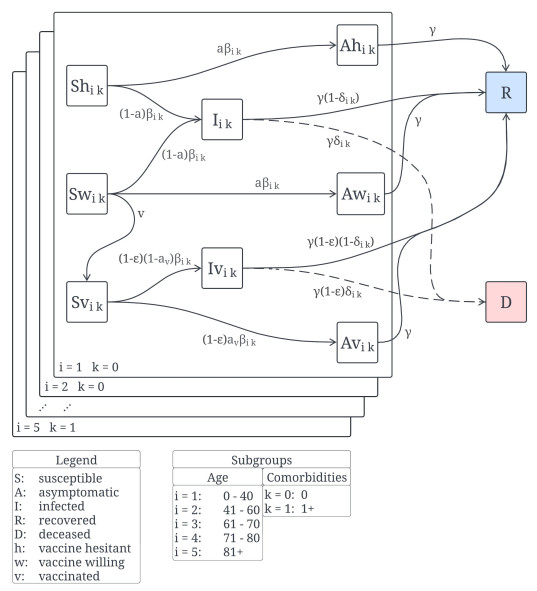









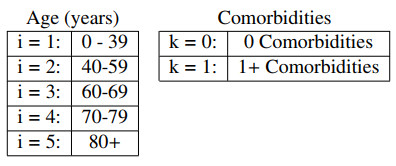
 DownLoad:
DownLoad:
